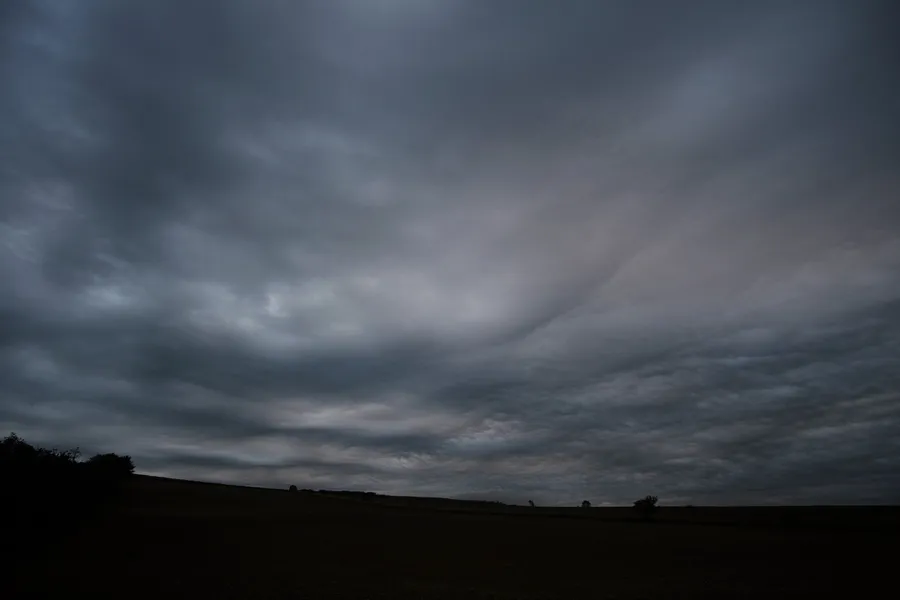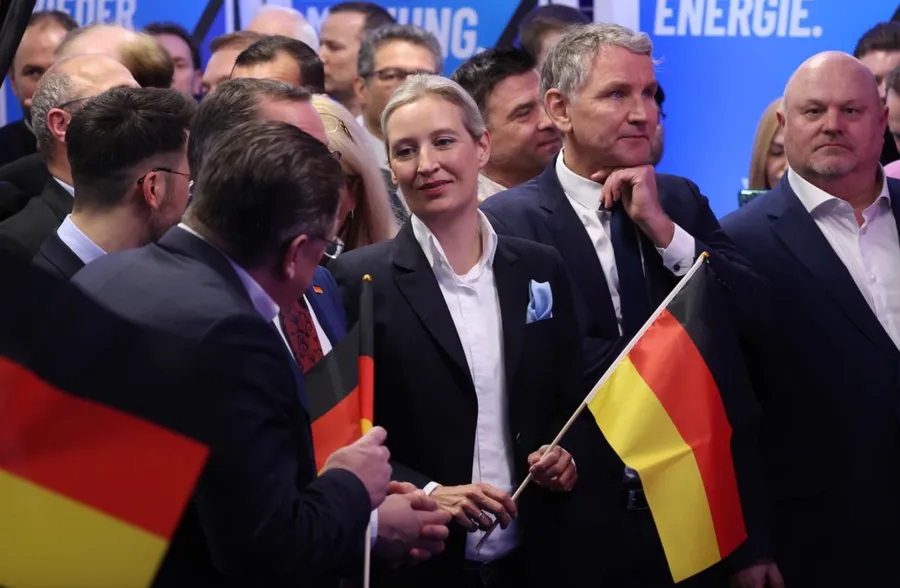
Projekt 2029: Leaked Plans of Germany’s Far-Right AfD to Grasp Power
by Thomas R Ullmann
In July 2025 an internal strategy paper from the far-right Alternative für Deutschland (AfD) surfaced in the press. Branded Projekt 2029, an overt nod to the far-right US initiative Project 2025. The document sketches a path to power that runs through demographic-targeting, rhetoric, and time-lines. This article sets the leak in its political context, unpacks the strategy’s key planks, and weighs the risks and ramifications for Germany’s federal democracy.
The Background
The AfD Factions, Realists versus Fundamentalists
Since 2023 the AfD has balanced two branches,
- The Realpolitik caucus (Weidel, von Storch, Chrupalla), which argues that “respectable optics’’ are prerequisite for coalition talks. Dr. Alice Weidel, the leading figure in the group, is an economist and ex-Goldman Sachs consultant who has co-chaired the AfD since 2022 and heads its parliamentary group in the Bundestag. Marketed as the party’s polished, pro-business face, she lives part-time in Switzerland with her wife and their two sons—projecting a cosmopolitan veneer while championing hard-line anti-immigration and anti-EU positions. She knows her audience, appealing to moderate ears with calm rhetoric though this hides an overt racist tendency of thought. In an e-mail dated February 2013, published four years later by Welt am Sonntag, Alice Weidel wrote that Germany was being “overrun by Arabs, Sinti and Roma” and governed by “pigs (Schweine) who are nothing but puppets of the Allied victors.”[1]
- The Fundamentalists (Höcke, Brandner), who push slogans such as Remigration (forced return of migrants) and flirt with identitarian ideas declared extremist by the Federal Office for the Protection of the Constitution (BfV).[2] Germany’s domestic-intelligence service classifies Höcke’s state branch of the AfD as a “confirmed right-wing extremist” organisation. Höcke is notorious for speeches that echo Nazi-era rhetoric and is currently facing hate-speech charges under Germany’s anti-incitement laws.
The tension between the factions has already produced public rows. For example, recently the Thuringian faction refusing to soften anti-EU rhetoric during the European campaign.
Breaking the Brandmauer and adoption of AfD polices
Since 2018 the CDU has pledged a Brandmauer—a firewall against cooperation with either the AfD or Die Linke(The left wing part with far-left elements). Yet a 2025 WZB study of 2 452 roll-call votes shows CDU representatives backing AfD motions in 22.4 % of municipal votes in Saxony.[3]
CDU leader Friedrich Merz insists the firewall stands nationally, but calls local deals "pragmatic". This in itself can be seen as a compromise suggestive of the wall’s weakening.
Critics warn that the line between tactical pragmatism and strategic convergence is blurring fast. There is clearly a divide within the CDU with some flirting with cooperation that is dismissed in public whilst others wish to mimic AfD policy to out AfD the AfD themselves. In various nations such strategies have tended towards a spiral towards more extremist policies matched with more extremist rhetoric.

A float portrays co-leader of the far-right Alternative for Germany (AfD) party Alice Weidel as witch during the parade to celebrate Rose Monday (Rosenmontag) in Duesseldorf, western Germany on March 3, 2025. (Photo by INA FASSBENDER / AFP)
Merz’s "Five-Point Plan" on asylum, unveiled in January 2025, echoes AfD frames,
- Grenzschutz (enhanced border security) through the creation of accelerated-deportation centres that would remove rejected asylum applicants within days, an approach likely to conflict with the EU’s Schengen zone and existing due-process safeguards.
- An annual refugee cap.
- Designation of North-African transit states as "safe" thus forcing asylum seekers to return.
- An obligation to apply for asylum outside the EU.
- Suspension of automatic family reunification.[4]
Alice Weidel has since gleefully claimed plagiarism, suggesting the CDU is finally reading the AFD’s programme. In this case she may well be correct.
Polling Momentum, and Its Limits
AfD support surged from 10 % in late-2021 to peaks of 23 % in March 2024, fuelled by anger over energy prices and Ukraine fatigue.[5] Yet since the BfV’s (Germany’s federal domestic-intelligence service) formal declaration of parts of the party as proven extremist in May 2024, numbers plateaued. Current Forsa polls place AfD at 19 %, the CDU/CSU at 28 %, SPD 17 % and the Greens 14 % (fieldwork conducted over 1–3 July 2025).[6]
The plateau sharpened debates inside the AfD. Realists cite it as evidence that a glass ceiling demands professionalisation. Fundamentalists counter that "watering down" the message depresses mobilisation in the east.
Constitutional Red Lines
The BfV’s extremist designation increases surveillance powers over AfD regional branches and jeopardises their access to public party-financing.
Constitutional scholars such as Sophie Schindler note that the AfD walks a tightrope: any formal attempt to ban the party via the Constitutional Court would require proof it "actively seeks to dismantle the democratic order"—a high bar met only twice in German history.[7]
Federal State Dynamics
Germany’s federal structure produces sharp regional contrasts. In the two east-German states that return to the polls on 1 September 2025 the AfD is currently out in front,
- Thuringia. An INSA poll published 8 May 2025 puts the AfD at 35 %, eleven points ahead of the CDU (24 %).[8]
- Saxony. INSA’s 7 June 2025 survey likewise gives the AfD 35 %, nine points clear of the CDU (26 %).[9]
Winning the ballot, nevertheless, is not the same as winning power. YouGov’s MRP seat model of 20 Feb 2025 projects the AfD to take about one-third of Saxony’s Bundestag-level mandates (37 % of second votes), still far from a majority so long as every other party refuses to cooperate.[10]
CDU minister-president Michael Kretschmer has floated Projekt Sacharbeit,"case by case" deals in the Landtag without a formal coalition, but the Berlin party leadership insists on preserving the Brandmauer against the AfD.[11] If the firewall ever broke, Saxony and Thuringia, where AfD support is strongest, would be the first places to show cracks.
The AfD’s Bid for Power, Projekt 2029
On 11 July 2025 Die Zeit published a leaked AfD strategy paper that outlines a honed strategy in order to gain power in Germany. Its core promise is simple, deliver Alice Weidel, a co-chair of the AfD, to the chancellery by 2029, or earlier if the CDU-SPD coalition collapses.[12] Three pillars underpin the plan.
- Escalate a Kulturkampf (culture war) on gender, climate and migration.
- Exploit fissures inside the CDU/CSU (The centre-right CSU is CDU’s sister party in Bavaria) and between the CDU and SPD, the main centre-left party.
- Repackage radical demands in a seemingly pragmatic tone, borrowing marketing tricks from TikTok and the US Freedom Caucus.

Alice Weidel on election evening Photo: Sean Gallup (Getty Images)
The document also recognises that the AfD must overcome its own internal split between the nationalist wing around Björn Höcke and the more media-savvy parliamentary leadership.
Overall a road map to 2029 is outlined as such,
- 2025–27 — “Firewall Erosion”: repeated test votes in the Bundestag and state parliaments designed to lure conservatives into ad-hoc alliances.
- 2028 — Voter-Basket Broadening: rollout of tailored appeals to the four weak segments; first open signals of coalition readiness to CDU/CSU.
- Early 2029 — Federal Campaign: enter the race as the “only credible conservative anchor,” working slogan: “Deutschland zuerst, ohne Extreme.”[13]
Image-Polishing and Economic Rebranding
The leaked memo walks a tightrope between respectability and radicalism. On one hand, a freshly adopted Verhaltenskodex tells functionaries to avoid Nazi allusions, tone down heckling in parliament and "dress professionally." On the other, the strategy explicitly forbids repudiating its most incendiary talking point—“Remigration" (deportation, including German citizens with dual nationality), insisting that the concept should "stay in the background, but never be disavowed."[13]
To woo centrist entrepreneurs and Mittelstand(owners of medium to small size businesses) voters otherwise loyal to the CDU/FDP, the paper proposes repackaging flat-tax and anti-EU regulations as a defence of Germany’s post-war social market economy. The promise: fewer Brussels directives, leaner domestic bureaucracy and "relief for the productive middle."[13] The strategy is clear, to package isolationist policy as favouring the middle class.
Breaking the Brandmauer and the constitution
AfD’s top tactical objective is to smash the conservative firewall that keeps it out of power. Tasked with the job, senior MP Beatrix von Storch sketches a U.S-style polarisation playbook: cast politics as a duel between a “bourgeois-conservative camp” (AfD + disaffected CDU voters) and a “radicalising left.” The intent is to make cooperation with the AfD the lesser evil for Chancellor Merz’s bloc.[14] Already there is evidence of this manifesting in east-German states though this may struggle to translate to west-German states and their distinctly different political landscape.
Additionally to the hindrance of the Brandmauer, party lawyers flag two existential threats: a formal ban by the Federal Constitutional Court and further classification as a "proven extremist" organisation. Yet the memo concludes that "heightened conflict mobilises our milieu," urging cadres to treat legal skirmishes as recruiting tools and to project professional moderation in public appearances.[13,15]
It remains to be seen how effective ostracising the AfD is. There is a risk that this appears to legitimise the argument; they are outsiders fighting the establishment, that their suppression is a greater need for urgency.
Micro-Targeting and Tiktok strategies
Four demographics,women, pensioners, academics and big-city residents, are singled out for "socio-demographic micro-analysis." Local front groups and issue-specific messaging are to identify "bridge themes" (e.g. safety for older women, academic freedom for professors) that move each subset toward AfD without diluting core positions.[14]
There is a clear emphasis on the younger voter with TikTok outlined as an important growth lever. Short, outrage-driven clips of Alice Weidel’s Bundestag speeches serve as the model: 30-second bursts linking migration to violent crime and "Islamisation." The strategy mandates a daily rhythm of viral content calibrated for the For-You page.[13] Already the AfD has published TikTok clips that blend alarmist border footage with lifestyle snippets, for example Alice Weidel’s viral in-car dance and Bundestag member Hannes Gnauck posting in Bundeswehr kit to discuss conscription. Political scientist Uwe Jun argues that such content helps “normalise” the party by forging parasocial ties before the hard-line frames drop.[16–18]
A Test of Democratic Resilience, Moderates Must Respond
The AfD’s leaked blueprint confirms what many suspected. The party wagers that Germany’s cordon-sanitaire can be broken. Whether that bet pays hinges on two moving parts,
- Can the CDU resist the gravitational pull of electoral maths and keep the Brandmauer intact? The weakness lies in the AfD-leaning east Germany.
- Can the AfD discipline its radical flank long enough to appear coalition-worthy while retaining its insurgent brand?
This latter point is a matter of rhetoric and optics. In general, the success of far-right ideology has many components but often one of their greatest strengths is their ability to harness tailored messaging, and knowing their audience well. This is evident from the leaks and should serve as an ominous sign that the AfD understand how to dress their extreme positions in moderate clothing, suited to a particular demographic.
Additionally, the party’s use of the term Projekt2029 shows an unashamed bond with the Trump administration. The success or failure of the latter may thus have consequence on the AfD’s own success.
The Grüne (the green party) could well exploit the shift of the CDU rightwards towards the AfD by taking the centre ground. With the SPD in coalition with the CDU this puts them in the most favourable position to do so with the FDP (A liberal party with small state ambitions) having failed to enter the current parliament.
With twin state elections this autumn, Germany’s post-war party geometry faces its sternest test since reunification. The firewall is showing cracks in the east. Whether it crumbles depends on choices made in the next eighteen months by both moderates and radicals alike.
References
1. Welt am Sonntag (2017).AfD-spitzenkandidatin weidel schrieb von “kulturfremden völkern”. Welt am Sonntag.
2.Annual report 2024(2024). (Federal Office for the Protection of the Constitution (BfV)).
3. Hummel, S., and Taschke, F. (2025).Is the brandmauer (“firewall”) breaking from below? Party cooperation with the AfD in local councils 2019–2024(Wissenschaftszentrum Berlin für Sozialforschung (WZB)).
4. CDU/CSU Parliamentary Group (2025).Fünf-punkte-plan zur asylpolitik.
5. Infratest dimap (2024).DeutschlandTrend monthly survey.
6. Institute, F. (2025).Politbarometer flash poll.
7. Schindler, S. (2024). Party bans and militant democracy in germany. German Law Journal 25, 567–590.
8. INSA Consulere (2025). Thüringen election poll.https://dawum.de/Thueringen/INSA/2025-05-08/.
9. INSA Consulere (2025). Saxony election poll.https://dawum.de/Sachsen/INSA/2025-06-07/.
10. YouGov (2025). MRP seat model: Bundesländer projections – saxony.https://de.wikipedia.org/wiki/Bundestagswahl_2025/Umfragen_und_Prognosen#Sachsen.
11. Die Welt (2024).„Mit der AfD wird es keine zusammenarbeit geben“, verspricht kretschmer. Die Welt.
12. Parth, C. (2025).Strategiepapier: AfD will ins kanzleramt. Die Zeit.
13. Parth, C. (2025).Strategiepapier der AfD: Wie die AfD an die macht kommen will. Die Zeit.
14. Angelos, J., Pezold, P. von, and Nöstlinger, N. (2025). German far right’s strategy for seizing power: Foment US-style polarization.https://www.politico.eu/article/germany-far-right-afd-power-strategy-polarization.
15. Escritt, T., and Marsh, S. (2025). Isolated and fearing a ban, germany’s far-right tones down the rhetoric.https://www.reuters.com/world/europe/isolated-fearing-ban-germanys-far-right-tones-down-rhetoric-2025-07-11.
16. Focus Online (2024). Weidel tanzt sich auf TikTok in die timeline der jugend.https://www.focus.de/politik/afd-tiktok-weidel.
17. Gnauck, H. (2024). Unser land, unsere regeln! (TikTok video).https://www.tiktok.com/@hannesgnauck/video/7364449025040469281.
18. Conesa, E. (2025).On x, elon musk normalizes the german far right. Le Monde.